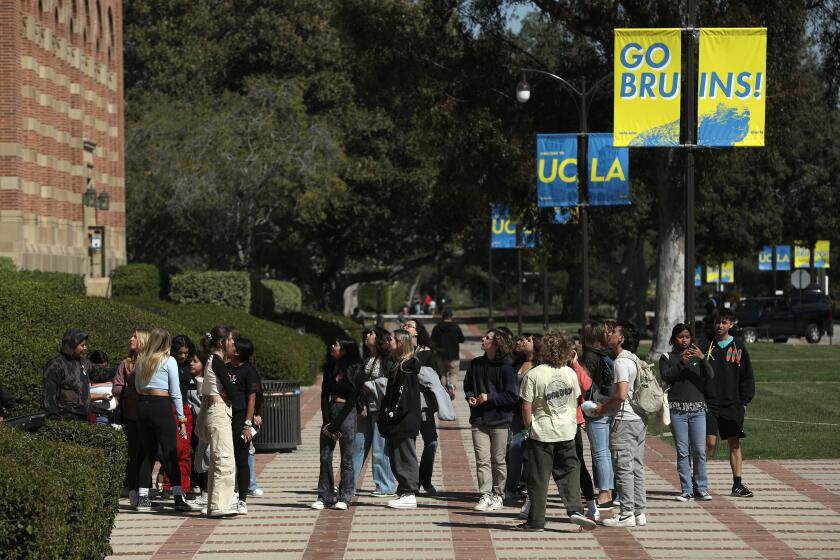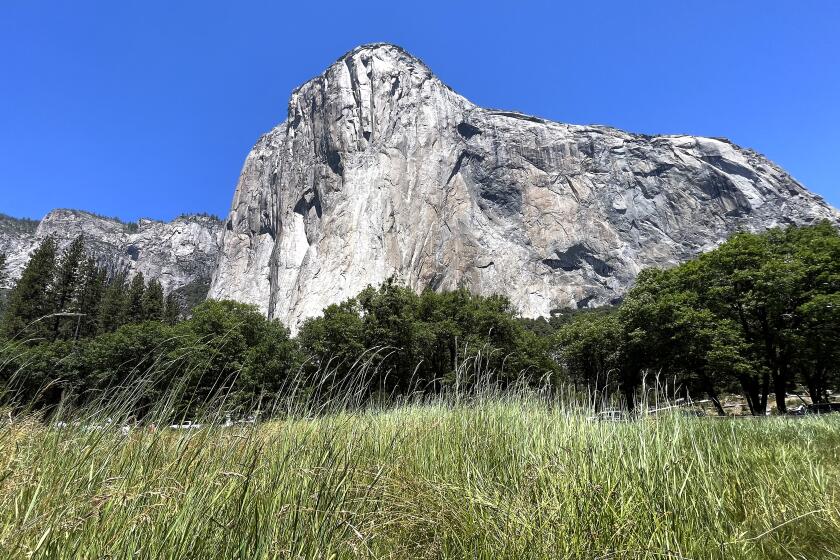In Redondo Beach, dead fish, perhaps millions of them, collect in King Harbor
- Share via
Redondo Beach awoke Tuesday to find a carpet of death laid atop the water, as if Davy Jones himself had burped up a couple hundred years worth of lunches. Thousands of silvery sardines floated atop the King Harbor marina fin-to-fin, with hundreds of thousands more, perhaps millions, piled on the coppery bottom, 18 inches deep in some spots.
If this was a natural event, as officials say it was, Mother Nature did not show her best face.
The Southern California coast, and Los Angeles County harbors in particular, have suffered from time to time from poor water quality and chemical intrusions. This, officials said, was not one of those instances. That didn’t make it any less icky — and the cleanup could take days or even weeks, and could soon pack an odiferous punch.
Photos: Massive fish die-off in King Harbor Marina
“At some point, they will float up to the surface and it’s not going to be pleasant,” said Larry Derr, head of bait operations at the harbor.
Authorities said it appeared that a massive, churning ball of sardines, and some mackerel and anchovies, was chased toward shore over the last few days, primarily from a spring storm that brought wind gusts of 45 miles per hour off the coast last weekend. Hungry, migrating whales spotted offshore in recent days may have added to the sardines’ plight.
So the sardines did what anyone might — they headed for safe harbor, to a picturesque complex of four marinas home to 1,400 boats, mostly private fishing boats, sailboats and cruisers, a jewel of an easygoing town of surf shops, dive bars and tanning salons.
There, they suffocated.
Even at high tide, King Harbor is only 22 feet deep, and though it is home to mackerel and perch, there simply wasn’t enough oxygen to support such a massive influx of fish, even of the four-inch variety, officials said. The basin of the marina complex the fish chose also happened to be a spot with very little water movement, critical for maintaining oxygen levels.
A strong tide, also caused by the storm, seemed to push the fish into two corners of the marina — one mass against the “M” and “L” docks, and another against the Redondo Beach break wall, which forms the border between Redondo Beach and Hermosa Beach and is home to a popular surf break.
By Saturday night, the fish were struggling. Allen J. Duran, owner of a boat washing and detailing company, was barbecuing knackwurst on the stern of his 27-foot boat, the Bachelor, when he peered into the water to find scores of sardines gasping above the surface — for oxygen from the air, since levels were already depleted in the marina.
“They were trying to breathe,” Duran said.
Brent Scheiwe, program director of the L.A. Conservation Corps’ Sea Lab, an ecology, education and job skills organization, said oxygen levels in the harbor typically measure at eight parts per million. Three parts per million is considered critically low, and by Tuesday morning, the water in the harbor was 0.72 parts per million — below lethal levels.
By then, it was over. A startling number of fish were dead, so many it seemed that one could stroll across the water. Occasionally, a plucky survivor could be seen picking its way among the dead. But for the most part, the harbor was lifeless, a sheen of flesh and scales shimmering in the sun and undulating en masse with the rise and fall of the sea.
“It looks like what happens to goldfish when you don’t change the water in the tank, mouth open and belly up,” said Redondo Beach City Manager Bill Workman.
State wildlife officials sent a batch of the fish to Sacramento, where they will undergo necropsies and chemical analyses. But they described that process as a formality; two independent water samples conducted Tuesday revealed no trace of toxins, nor any oil slick, nor any suggestion of an algae buildup that had caused problems in the past.
“It is a naturally occurring — but unusual — event,” said Andrew Hughan, a spokesman for the California Department of Fish and Game. “It’s just a mess.”
Redondo Beach relies mightily on its waterfront and has reason to be sensitive about this sort of thing.
Massive, stinking fish kills have struck King Harbor before, in 2003 and 2005. Both times, algae blooms robbed the harbor waters of life-enriching oxygen, causing fish to suffocate and die. Scientists believe such “dead zones” will increase as ocean waters continue a warming trend in a changing climate. Warmer waters prompt faster biological growth, just like molds and bacteria quickly devour food left out of the refrigerator.
In those episodes, despite efforts by boat owners to scoop up the dead fish, the rafts of decomposing flesh unleashed a powerful stench that plagued the harbor for weeks. Some boat owners complained of feeling sick from the smell.
“The main issue here is a quick response,” Redondo Beach Mayor Mike Gin said. “They’re going to have this cleaned up as quickly as possible.”
Even if the die-off is deemed a “natural” event, that doesn’t mean humans didn’t play a role.
Fish kills are almost always caused by decaying algae. Although oceans are awash in algae, those microscopic organisms bloom when fed by nutrients washing off the land. Tuesday’s episode follows unusually heavy rainfall in Southern California, which washed all manner of foreign stuff, from dog droppings to fertilizer, into the sea. Algae have begun to bloom along the coast in recent weeks as the days have grown longer, providing needed sunlight.
Sardines are strong swimmers, and it is possible — even likely — that their departure from the harbor was blocked not just by a strong tide but by a suffocating curtain of low-oxygen water.
This episode, meanwhile, could get worse before it gets better.
Authorities and dozens of volunteers were skimming floating sardines from the water Tuesday — they will be recycled and turned into fertilizer — and dive teams were expected to begin assessing how to siphon fish from the bottom, potentially with a giant vacuum cleaner.
An enormous task lies ahead. In the meantime, the fish will begin to decompose. That will draw bacteria, which will, in turn, consume more oxygen, Scheiwe said. More mass deaths are possible, and could fell large numbers of the fish more commonly seen in the harbor, namely mackeral and perch.
“It kind of compounds itself,” he said.
At least until the stench arrives, the die-off has become a source of morbid fascination. Dozens of looky-loos and amateur photographers flocked to the marina, pointing to struggling survivors in the mass and gasping as sweaty workers hauled wheelbarrows overflowing with sardines to waiting trucks.
Glen Thompson, 51, a local business owner and a King Harbor Yacht Club member for 25 years, dropped by the marina to check on work that was being done on his boats, a 27-foot fishing boat named Termite’s Delight and a 30-foot sailboat called Magic Carpet. He wound up, he said, “rubbernecking like everybody else.”
“Of course we’re concerned,” he said. “But it’s just a fluke. They happened to be out there, and like any smart animal, they sought refuge.… I’m a local boy. I’ve never seen anything like this.”
Times staff writers Tony Barboza and Andrew Blankstein contributed to this report.
More to Read
Sign up for Essential California
The most important California stories and recommendations in your inbox every morning.
You may occasionally receive promotional content from the Los Angeles Times.











